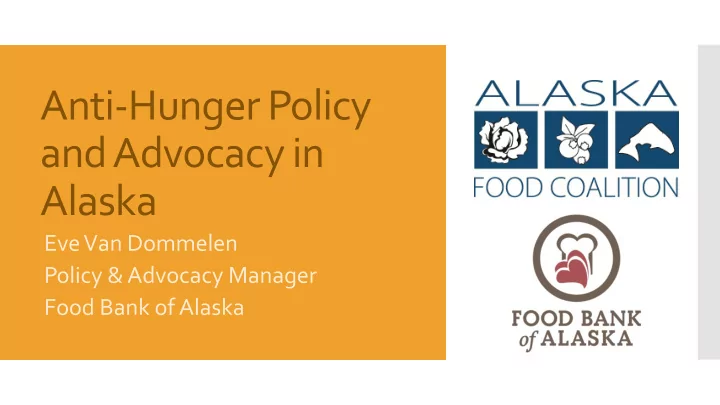

Anti-Hunger Policy and Advocacy in Alaska
Outline: Framing Food Security/Insecurity Food Security in Alaska Federal Policy and Advocacy State Policy and Advocacy SNAP FINI Grant Useful Reports Policy Recommendations
FOOD BANKS FOOD SECURITY SOLUTIONS Direct Food Distribution Efficiency/Short Term Relief Connect Clients with other Substitution/Capacity Building services and assistance Redesign Strategies programs Advocacy and Education FRAMING
“The U.S. Department of Agriculture (USDA) defines food insecurity as the lack of consistent access to enough food for an active, healthy life.”
Three Discourses on Food Security in Alaska: Local Cultivation: Agricultural Development, Emergency Preparedness Food Security Subsistence: Alaska Native Issues, Environmental in Alaska Issues, Mixed Market Economies, Alaskan Identity Poverty & Economic Insecurity: High Cost of Living, Rural/Urban Divide, Barriers to Basic Needs
1/7 Alaskans faces Food Insecurity (~107,000) 1/5 Alaska kids live in homes that may not have enough food ~155,000 Alaskans access the Alaska Anti-Hunger Hunger Network Annually Statistics in 60% of clients served at FBA and partner agencies worked for pay in the last 12 months Alaska 56% choose between paying for food or medical care 53% choose between food and housing 64% between food and transportation 59% between food and utilities
Federal Policy & Advocacy Nutrition Title in the 2018 Farm Bill SNAP ABAWD Rule The Emergency Food Assistance Program (TEFAP) Child Nutrition Reauthorization Summer Meals Act
State Policy & Advocacy State Budget SNAP Administrative Policies Electronic Application Electronic/Telephonic Signature Pre-Release Waiver Elderly Simplified Application (ESAP) Asset Limit & Transitional Benefits
Some SNAP Facts : In a typical month in 2018, SNAP helped an average of 85,111 Alaskans 20% of Alaska’s Children rely on SNAP SNAP eases the burden on the anti-hunger network in Alaska, as well as individuals trying to meet their basic needs. SNAP in SNAP is an incredible economic stimulator – every $5 of federal Alaska SNAP benefits generates nearly $9 in local economic activity. In 2018, SNAP benefits pumped about $175 million into Alaska’s economy SNAP & Local Ag: SNAP is available at some farmers’ markets Senior Farmers’ Market Nutrition Program Limitations
FINI Grant 2019 Updates: Gus Schumacher Nutrition Incentive Program (GusNIP), Produce Prescription, Nutrition Incentive Program Training GusNIP is essentially a SNAP double-bucks program FBA to apply for a GusNIPGrant collaboratively with other organizations in 2020 GusNIP requires a 50% match
Useful Reports Map the Meal Gap, 2019 Hunger in America Study, Alaska Report (2014) The Importance of Local Foods in Mitigating Poverty- Related Food Insecurity (report on rural hunger in Alaska), Burke & Durr We are in the beginning stages of planning a Hunger in Alaska Study for Fall 19/Spring 20
Policy Recommendations Ask Alaska State Legislature to match FINI Grant funds – FBA and partners plan to apply collaboratively for a GusNIP grant in June of 2020. Matching funds from the legislature would not only make this grant possible, but also show that the legislature supports Alaskans struggling with food insecurity. The GusNIP grant has the potential to have a co-benefit of being able to support local agriculture through increasing the capacity of low-income Alaskans to buy Alaska-grown produce. Support increase to the SNAP asset limit/transitional benefits – this policy ask would help support low-income Alaskans as they move towards self-sufficiency. Rather than losing necessary benefits as they gain better employment and wages this would allow Alaskans to transition more slowly off of benefits allowing them to save money for future extenuating circumstances Maximize Federal Funds for Nutrition Programs – not only does this support low-income Alaskans, this supports Alaskan communities that can benefit from increased Federal dollars being pumped into local economies and infrastructure.
Recommend
More recommend